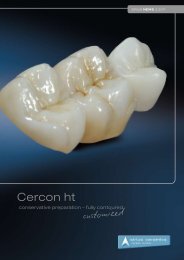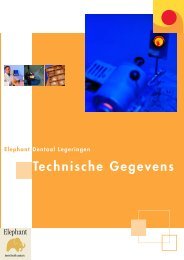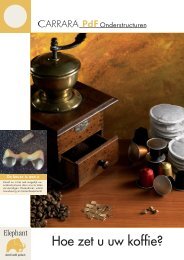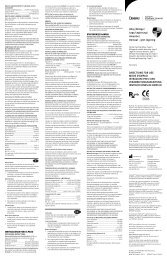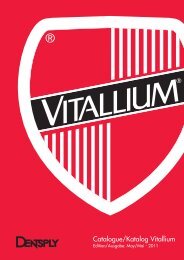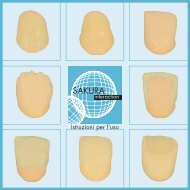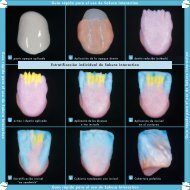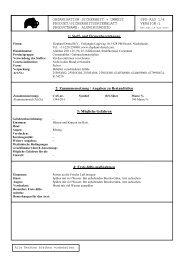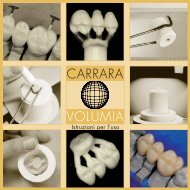Antagon Interaction
Antagon Interaction
Antagon Interaction
You also want an ePaper? Increase the reach of your titles
YUMPU automatically turns print PDFs into web optimized ePapers that Google loves.
ANTAGONinteractionUser instructions
Elephant Dental’s mission statement.Our aim is to make a positive contribution to the society through the development, manufacture anddistribution of innovative, high quality product systems that are guaranteed to facilitate the work of dentalprofessionals and increase patient satisfaction.Indication:Elephant<strong>Antagon</strong> <strong>Interaction</strong> is the normally expanding, highmelting dental ceramic for traditional alloys.<strong>Antagon</strong> <strong>Interaction</strong> can be easliy fired onsub-structures with a thermal expansion coefficientbetween 13.8 and 14.9 µm/m.K (25-500ºC).Contraindication:If patients are known to be allergic to any of thecomponents, the material should not be applied.dental health products2
Controlled interaction.<strong>Antagon</strong> <strong>Interaction</strong> is the new normally expanding,high-melting generation of controlled-interactivityceramics for traditional alloys. With this ceramic, itis possible to prepare a restauration which exhibitsprecise control over the light and colour characteristicsonce it has been placed in the patient’s mouth.The layering structure developed during buildupcreates a natural interaction of opalescence andfluorescence. With this intelligent type of ceramic,the restoration reflects every incidence of light asnaturally as a normal tooth would.Control and precision.The layering structure is created in the usual way.The dental technician can exercise precise controlover the restoration’s layers, ensuring that the resultmeets all requirements. The highly pragmatic andsimple organisation of the harmonised system ofcolours and powders is reflected in all the componentsof our product range, the ceramic powders(jar labels), the layer organiser and the layeringinstructions.TABLE OF CONTENTS.PAGEColour determination 4Layer organiser instructions 5Information regarding underlying copings 6Paste opaque 7Opaque dentin 8Dentin 9Action-i dentin & x-tra incisal 10Incisal 11X-tra i bright, medium & dark 12Correction & glaze 13Standard layering structure forUnderlying metal copings 14Individual layering structure 15Firing and layering structure 16Guidelines for the use of ceramic furnaces 17The interaction of fluorescence, opalescence,colour and light yields naturalaesthetics.With its functional, layered structure, <strong>Antagon</strong><strong>Interaction</strong> has a natural look. Consequently, all layers,whether deep in the restoration or close to theroots are fluorescent, while the remaining layers arepredominantly transparent and opalescent. Thisfunctional division of properties – where propertiesare geared to one another precisely – makes thispatented system unique and gives rise to the interplay(interaction) that occurs automatically in normalstructures. As a result, crowns have a completelynatural appearance.3
Colour determination and<strong>Antagon</strong> <strong>Interaction</strong> shadeguides.<strong>Antagon</strong> <strong>Interaction</strong> is 100% compatible withLumin ® vacuüm/Vitapan ® classical.However, it is vital that technicians working on therestoration use the same reference material and communicateclearly with one another. The <strong>Antagon</strong><strong>Interaction</strong> shadeguides’ pellets are made of the originalceramic, which enable simple and accuratecolour determinationopaque dentin shadeguideAccurate colours.The <strong>Antagon</strong> <strong>Interaction</strong> system employs colourinformation in a consistent manner. The colourof the completed restoration matches the tooth’snatural colour. Powder combinations can easilybe determined using the layer organiser.dentin shadeguideInstructions for optimal colour determination.Ask yourself the following questions from time totime:• Am I determining the colour under consistent lightconditions?• Is my perception affected by the environment(e.g. sharp colour contrasts)?• Am I using the right shadeguide?• Am I examining the patient’s mouth under theoptimal 45° angle?incisal shadeguide4Shadeguide of original ceramic
Layer OrganiserIndication of the powders to be usedIndication of the x-tra incisals that maybe usedThe layer organiser.The layer organiser is a practical and easy-to-usetool to determine which powders are needed tocreate the intended colour. From bottom to top –paste opaque to incisal –, the powders associatedwith the colours involved can be determined accurately.Slide open and read.If you slide open the large lower part of the layerorganiser, you can read, in logical order, whichcolour combinations are required to create the layerstructure displayed. When applying the incisals orcolour corrections between the first and second dentinfiring, the colour can be lightened or darkenedusing x-tra i bright, x-tra i medium or x-tra i dark.Individual wishes are easily met.The upper part of the layer organiser shows theoptions for specific colours. During the final constructionphase of the layered structure, the incisalthird section of the element can be adjusted to thepatient’s wishes. The x-tra incisals are all opalescentand yield a natural result due to their interactionwith the underlying layers.paste opaque A1 A2 A3 A3,5 A4 B1 B2 B3 B4 C1 C2 C3 C4 D2 D3 D4opaque dentin A1 A2 A3 A3,5 A4 B1 B2 B3 B4 C1 C2 C3 C4 D2 D3 D4dentin A1 A2 A3 A3,5 A4 B1 B2 B3 B4 C1 C2 C3 C4 D2 D3 D4action-i dentin 1A2 3A4 1B2 3B4 1C2 3C4 1A2 1B2 1C2x-tra incisalx-tra i blue/x-tra i red/x-tra i grey/x-tra i orange/x-tra i clearx-tra i bright/x-tra i medium/x-tra i darkincisal 58 59 60 57 59 60 59 60 595
Elephant alloys Biogold Plus, high gold content Orion WX: reduced gold content<strong>Antagon</strong> <strong>Interaction</strong>, the ceramic fortraditional alloys.<strong>Antagon</strong> <strong>Interaction</strong> can be easily fired on enamelingalloys with a thermal expansion coefficientbetween 13.8 and 14.9 µm/m.K (25-500°C).Only the time needed for cooling may vary:Rapid cooling (0 min.) of alloys with a thermalexpansion coefficient up to 14.0 µm/m.K(25-500°C).Normal cooling (2 min.) of alloys with a thermalexpansion coefficient up to 14.3 µm/m.K(25-500°C).Slow cooling (5-7 min.) of alloys with a thermalexpansion coefficient from 14.4 µm/m.K(25-500°C).Biogold Plus, yellow gold enamelingalloy with a high gold content.Observe the following instructions when preparing anunderlying shell with Biogold Plus:• Oxydation: 3 minutes at a temperature of 950°Cwithout vacuum.• Oxide reduction: sandblast the preparation with125µm aluminium oxide at a maximum pressure of2 bar or submerge and clean the material in aclean pickling solution for a maximum of 1 minute.• Cool down normally after each firing (2 minutes).(Or, if this is impossible, cool down slowly for 5minutes)Orion WXgold-reduced enameling alloy.Observe the following instructions when preparingan underlying shell with Orion WX:• Oxydation: 5 min. at a temperature of 950°Cwithout vacuum.• Orion WX: Cool down rapidly after each firing(0 min.).In view of the special processing methods,observe the user instructions provided by thealloy’s supplier. Crucial information regarding themost commonly used Elephant Dental alloys isincluded below.Elephant offers a wide range ofalloys.<strong>Antagon</strong> <strong>Interaction</strong> is highly suitable for usewith the following Elephant alloys:For more detailed information, please ask forour alloy chart.Alloy TCE (25-500°C) Cooling Down with <strong>Antagon</strong> <strong>Interaction</strong> GoldOrion UX 13,8 Quick (0 min.) 77,0Orion WX 13,8 Quick (0 min.) 52,0Orion Vesta 13,8 Quick (0 min.) 2,0Bermudent H 14,0 Quick (0 min.) 78,0Orion UX Plus 14,1 Normal (2 min.)* 77,1Orion UWX 14,1 Normal (2 min.)* 75,0Orion GX 14,1 Normal (2 min.)* 84,0Orion Isis Plus 14,2 Normal (2 min.)* 15,0Biogold Plus 14,3 Normal (2 min.)# 86,5Bermudent Y 14,3 Normal (2 min.)# 86,0Biogold AN 14,3 Normal (2 min.)# 86,0BioGold <strong>Interaction</strong> 14,3 Normal (2 min.)# 86,0BioGold Pure 15,0 Normal (4 min.) 1 99,8Orion E 14,4 Slow (5 min.) 52,0Orion Argos 14,7 Slow (7 min.) 0,16* Or, if this is impossible, quickly # Or, if this is impossible, slowly1Despite the high TCE value, cool down normally because of its special composition.
Excellent bonding.DentinThe new paste opaque ensures optimalbonding with all conventional alloys,regardless of their application.OpaqueAlloyOrion Argos, PalladiumsilverCross-section of a crownOrion ArgosPalladium-silver enameling alloy.Observe the following instructions when preparingan underlying shell with Orion Argos:• Oxydation: 5 minutes at a temperature of950°C without vacuum.• Oxide reduction: not applicable when usingOrion Argos.• Cool down slowly (7 minutes) after each firing.1Finishing:Finish the material using carbide burs or ceramicbonded stones, or both. In the final stage, thematerial may only be polished in one directionusing delicate crosscut carbide burs! Sandblastwith 125 µm aluminum oxide (max. pressure: 2-3bar). Clean the material using a steam cleaner orin an ultrasonic bath with distilled water.Alternatively, observe the specific instructions ofother alloy suppliers.Recommended toolsPlatinum Palladium Silver9,6 9,2 1,5- 38,0
iPencil and Pencil (Brush) Cleaner:Important: After removing it from its package, thepaste opaque is ready for immediate use. Use theenclosed pencil (brush) cleaner only to moisten orclean the brush. During processing, do not usewater to clean the brush. If paste opaque comesinto contact with water, cracks or air bubbles mayform in the opaque layer during firing.2Applied paste opaqueAvailable colours: A1, A2, A3, A3,5, A4,B1,B2, B3, B4, C1, C2, C3, C4, D2, D3, D42a Processing:First opaque layer:• Take the required quantity of paste opaque from thesyringe.• Use the enclosed paste opaque brush.• Mix the material thoroughly.• Apply the first opaque layer evenly from the incisaledge to the cervical. Make sure that it covers theentire surface.• For a smoother surface, file the applied layer toincrease its density.Firing chart:Drying Starting Vacuum starting Rate oftemp. temp. temp. heat increase7 min. 400°C 400°C 60°C/min.Final temp. Hold time Surface appearance915°C 2 min. eggshell glossANTAGONinteractionConsult the layer organiser to optimise the layering structure.2bProcessing:Second opaque layer:• Apply the second opaque layer evenly.• For a smoother surface, file the applied layer toincrease its density.Processing:Drying Starting Vacuum starting Rate oftemp. temp. temp. heat increase7 min. 400°C 400°C 60°C/min.Final temp. Hold time Surface appearance910°C 2 min. * eggshell gloss* 1 min. with vacuum, 1 min. without vacuumANTAGONinteractionopaque dentin3Processing:Together, the opaque dentin and dentin constitute thebasic layer of colour of the entire layering structure.With <strong>Antagon</strong> <strong>Interaction</strong>, the fluorescent layers areconcentrated in more deeply lying part of thebuildup. As a result, the reflected white lightenhances the opalescent characteristics of the transparentupper layers. The opaque dentin can also beapplied where little space is available and lesstranslucency is required, for instance at the gingivalor palatinal/lingual area of intermediate elementsand at places where there is little space for a standardceramic structure.Available colours: A1, A2, A3, A3,5, A4,B1, B2, B3, B4, C1, C2, C3, C4, D2, D3, D483Applying the opaque dentin
ANTAGONinteractiondentin4Applied dentinAvailable colours: A1, A2, A3, A3,5, A4,B1, B2, B3, B4, C1, C2, C3, C4, D2, D3, D45Reduced dentin (cutback)4 Processing:5 Processing:• Use carving liquid to mix the selected dentin to acream-like consistency.• Superwet liquid may be used for larger restorationsto enable longer working time.• Examine the unreduced restoration to determinethe proper dimensions of the crown and removeany excess material (cutback technique).—The restoration may also be worked directly inits final form.ANTAGONinteraction• Cutback the material to create the desiredspace for the incisal material.• More material must be removed whenaction i-dentin is used.• An irregularly shaped dentin core ensuresoptimal distribution of light (see photo).Consult the layer organiser to optimise the layering scheme.iStandard or individual:Use of either a standard or individual layeringstructure is determined by the amount of cutback ofthe dentins. To create a standard layering structure,follow the steps indicated on the pictures on page14. Incisal is added to the reduced dentin, afterwhich the crown is fired. To achieve individual layeringcharacteristics, use action i-dentins and x-traincisals.paste opaque A1 A2 A3 A3,5 A4 B1 B2 B3 B4 C1 C2 C3 C4 D2 D3 D4opaque dentin A1 A2 A3 A3,5 A4 B1 B2 B3 B4 C1 C2 C3 C4 D2 D3 D4dentin A1 A2 A3 A3,5 A4 B1 B2 B3 B4 C1 C2 C3 C4 D2 D3 D4action-i dentin 1A2 3A4 1B2 3B4 1C2 3C4 1A2 1B2 1C2x-tra incisal x-tra i blue/x-tra i red/x-tra i grey/x-tra i orange/x-tra i clearx-tra i bright/x-tra i medium/x-tra i darkincisal 58 59 60 57 59 60 59 60 599
ANTAGONinteractionincisal8a Covering the edges with incisalAvailable colours: 57, 58, 59, 60 8b Incisal sandwich structure8aProcessing:The opalescent properties of <strong>Antagon</strong> <strong>Interaction</strong>incisals have a natural and aesthetic effect on thecrown, even with changing light conditions.Opalescence is guaranteed through five firings. Foroptimal effect, <strong>Antagon</strong> <strong>Interaction</strong> incisal powdersmust be applied in relatively thin layers.• Use carving liquid to mix the <strong>Antagon</strong> <strong>Interaction</strong>incisal, like the dentin, into a cream-like consistency.• Superwet liquid may be used for larger objects toenable a longer treatment of the restoration.CARRARAANTAGONinteraction8bProcessing:The incisals can be used together with thex-tra incisals to obtain a variegated layeredstructure.interaction ® 11Consult the layer organiser to optimise the layering scheme.9‘A slightly darker tone:’:The colour value can be very accurately controlledusing x-tra incisals bright, medium and dark.For example, you can use x-tra i dark if the processinginstructions indicate that the cervical should be a bitdarker.9aFully covered with incisal119bPalatinal covering
Lighter? => x-tra i brightANTAGONinteractionBrightx-tra incisal11ax-tra i bright applied before the second firing11bThe crown after the second firingNeutral? => x-tra i medium11 The use of bright, medium and dark x-traincisals enables the adjustment of the crown’s colourin the final stage without having to polish the restoration.ANTAGONinteractionMediumx-tra incisalFiring chart for second phase:Drying Starting Vacuum starting Rate oftemp. temp. temp. heat increase3-5 min. 500°C 500°C 60°C/min.Final temp. Hold time Surface appearance890°C 1-2 min. matte finish10The crown after the first firing10Firing chart for first phase:Drying Starting Vacuum starting Rate oftemp. temp. temp. heat increase5-7 min. 500°C 500°C 60°C/min.Final temp. Hold time Surface appearance895°C 1-2 min. matte finishDarker? => x-tra i darkExample: A3 crowns with ...bright medium dark*A slightly darker toneThe colour value can be very accurately controlledusing x-tra incisals bright, medium and dark.For example, you can use x-tra i dark if the processinginstructions indicate that the cervical should be abit darker.ANTAGONinteractionDarkx-tra incisal12
i Processing 1:i Processing 2:• Use carving liquid to mix <strong>Antagon</strong> <strong>Interaction</strong>correction into a cream-like consistency.• Apply the desired quantity to the location to becorrected and condense it thoroughly.• Fire the material in accordance with the firing chart.• Use stain liquid (and selected stains, if required)to mix the material into a cream-like consistency.• Apply the desired quantity to the location to becorrected and increase its density.• Fire the material in accordance with the firing chart.ANTAGONinteractioncorrectionFiring chart 1:Drying Starting Vacuum Rate oftemp. temp. heat increase3-5 min. 500°C yes 60°C/min.Final temp. Hold time Vacuum Surface appearance830-850°C 1-2 min. 1 min. semi-glossyFiring chart 2:Drying Starting Vacuum Rate oftemp. temp. heat increase6 min. 500°C up to 880°C 60°C/min.Final temp. Hold time Vacuum Surface appearance880°C 1-2 min. 0 min. semi-glossyiEasy correction material:<strong>Antagon</strong> <strong>Interaction</strong> correction is an unpigmented andlow-fusing material with physical properties that arecompatible with those of <strong>Antagon</strong> <strong>Interaction</strong>. It canbe used to:• correct contact points.• correct occlusal or incisal edges.• improve the surface shape.ANTAGONinteractionANTAGON+CARRARAinteractionglazei Shaping the surface: essential foroptimal opalescence.The shape of the surface is key to the restoration’saesthetic properties, especially those related to theincidence of light. The surface structures of the neighbouringelements on the plaster model can be highlightedusing silver powder. This helps to determinewhat the surface structure should be like.12Processing:• Mix <strong>Antagon</strong>+Carrara <strong>Interaction</strong> glaze and stainliquid until it is an even and cream-like mass.• Apply a thin layer on the surfaces and distributeevenly.• Fire the material in accordance with the firing chart.Firing chart:Drying Starting Vacuum Rate oftemp. temp. heat increase2-3 min. 500°C no 60°C/min.Final temp. Hold time Vacuum Surface appearance885°C 1-2 min. no glossy1312Completed glossy crown
1 paste opaque2 opaque dentin3Fully built-up dentin<strong>Antagon</strong> <strong>Interaction</strong> layering scheme for a standard layered structure with underlying metal copings4Reduced dentin (cutback)5Covering edges with incisal6Fully covered with incisal7 First firing8 Second firing9 Completed crown14
1 Applied paste opaque2 Applying the opaque dentin<strong>Antagon</strong> <strong>Interaction</strong> individual layering scheme3Reduced dentin (cutback)4 Applied action-i dentin5 Applying various x-tra incisals6 Covering the edges with incisal7 Incisal sandwich structure8 Fully covered with incisal9 Completed glossy crown15
StratoPlus/StratoPress(general firing programme)1 st pasteopaque2 nd pasteopaqueMargin1 st Dentin2 nd Dentin Glaze CorrectionmassPreheat orstarting temperature: (°C) 400 400 500 500 500 500 500Drying andpreheating time: (min) 7 7 4 5–7 3–5 4 3–5Rate ofheat increase: (°C/min) 60 60 60 60 60 60 60Final temperature: (°C) 915 910 895 895 890 885 830–850Hold time: (min) 1–2 1–2 1–2 1–2 1–2 1–2 1–2Vacuum starting temp. (°C) 400 400 500 500 500 – 500Vacuum final temp. (°C) 915 910 895 895 890 – 830–850Choice of ceramic alloy:<strong>Antagon</strong> <strong>Interaction</strong> can be easily fired on enamelingalloys with a thermal expansion coefficient between13.8 and 14.9 µm/m.K (25-500°C).Quick cooling down to 14.0 µm/m.K – 0 min.Normal cooling down to 14.3 µm/m.K – 2 min.Slow cooling down from 14.4 µm/m.K – 5-7 min.Important:The firing temperatures indicated are target values.Temperatures may vary from one ceramic furnaceto another and must be adapted accordingly.StratoPlusCooling down phase:Alloy WAK(25-500°C)Cooling downwith <strong>Antagon</strong> <strong>Interaction</strong>Orion UX 13,8 Quick (0 min.)Orion WX 13,8 Quick (0 min.)Orion Vesta 13,8 Quick (0 min.)Bermudent H 14,0 Quick (0 min.)Orion UX Plus 14,1 Normal (2 min.)*Orion UWX 14,1 Normal (2 min.)*Orion GX 14,1 Normal (2 min.)*Orion Isis Plus 14,2 Normal (2 min.)*Biogold Plus 14,3 Normal (2 min.)#Bermudent Y 14,3 Normal (2 min.)#Biogold AN 14,3 Normal (2 min.)#BioGold <strong>Interaction</strong> 14,3 Normal (2 min.)#-BioGold Pure 15,0 Normal (4 min.) 1Orion E 14,4 Slow (5 min.)Orion Argos 14,7 Slow (7 min.)* Or, if this is impossible, quickly # Or, if this is impossible, slowly1 Despite the high TCE value, cool down normally because of its specialcomposition.paste opaque A1 A2 A3 A3,5 A4 B1 B2 B3 B4 C1 C2 C3 C4 D2 D3 D4opaque dentin A1 A2 A3 A3,5 A4 B1 B2 B3 B4 C1 C2 C3 C4 D2 D3 D4dentin A1 A2 A3 A3,5 A4 B1 B2 B3 B4 C1 C2 C3 C4 D2 D3 D4action-i dentin 1A2 3A4 1B2 3B4 1C2 3C4 1A2 1B2 1C2x-tra incisalx-tra i blue/x-tra i red/x-tra i grey/x-tra i orange/x-tra i clearx-tra i bright/x-tra i medium/x-tra i darkincisal 58 59 60 57 59 60 59 60 5916
Vacumat 2500Stand-bytemp.Finaltemp.DryingtimeHeatingrateHold timeTime vacuümON1 st paste opaque firing 400°C 915°C 7.0 60 2.0 1.82 nd paste opaque firing 400°C 910°C 7.0 60 2.0 1.8Margin firing 500°C 895°C 4.0 60 2.0 1.71 st dentin firing 500°C 895°C 6.0 60 2.0 1.52 nd dentin firing 500°C 890°C 4.0 60 2.0 1.5Glaze firing 500°C 885°C 4.0 60 0.5 0.0Correction mass firing 500°C 830°C 4.0 60 2.0 1.0Important:The firing temperatures indicated are target values.Temperatures may vary from one ceramic furnaceto another and must be adapted accordingly.Choice of ceramic alloy:<strong>Antagon</strong> <strong>Interaction</strong> can be easily fired on enamelingalloys with a thermal expansion coefficient between13.8 and 14.9 µm/m.K (25-500°C).Quick cooling down to 14.0 µm/m.K – 0 min.Normal cooling down to 14.3 µm/m.K – 2 min.Slow cooling down from 14.4 µm/m.K – 5-7 min.Austromat 30011 st opaque firing C400 T180 T240 • L9V9 T060 • C915 T60 VO T60 CO LO T2 C4002 nd opaque firing C400 T180 T240 • L9V9 T060 • C915 T60 VO T60 CO LO T2 C4001 st dentin firing C500 T120 T180 • L9V9 T060 • C895 T60 VO T60 CO LO T2 C5002 nd dentin firing C500 T120 T120 • L9V9 T060 • C890 T60 VO T60 CO LO T2 C500Glazefiring C500 T120 T120 • L9 T060 • C885 T60 CO LO T2 C500MarginfiringC500 T120 T180 • L9V9 T060 • C895 T60 VO T60 CO LO T2 C500Correction massfiringC500 T120 T90 • L9V9 T060 • C830 T60 VO T60 CO LO T2 C500Programat P90/P95Standbytemp.HeatingrateFiringtemp.ClosingtimeHold timeVacuumONVacuumOFF1 st paste opaque firing 400°C 60 915°C 7 1 450°C 915°C2 nd paste opaque firing 400°C 60 910°C 7 1 450°C 910°CMargin firing 450°C 60 895°C 4-5 1 450°C 895°C1 st dentin firing 450°C 60 895°C 5-7 1 450°C 895°C2 nd dentin firing 450°C 60 890°C 3-5 1 450°C 890°CGlaze firing 450°C 60 885°C 4 0,5-1 450°C –Correction mass firing 400°C 60 830°C 4 1-2 450°C 830°C17
Vacumat 200/250/300Stand-bytemp.Finaltemp.DryingtimeHeatingrateHoldtimeTime vacuumON1 st paste opaque firing 400°C 915°C 7.0 8.5 1.0 9.52 nd paste opaque firing 400°C 910°C 7.0 8.5 1.0 8.5Margin firing 500°C 895°C 5.0 6.5 1.0 7.01 st dentin firing 500°C 895°C 7.0 6.5 1.0 7.02 nd dentin firing 500°C 890°C 4.0 6.5 1.0 7.0Glaze firing 500°C 885°C 4.0 6.5 0.5 0.0Correction mass firing 500°C 830°C 4.0 5.5 1.5 6.0Important:The firing temperatures indicated are target values.Temperatures may vary from one ceramic furnaceto another and must be adapted accordingly.Choice of ceramic alloy:<strong>Antagon</strong> <strong>Interaction</strong> can be easily fired on enamelingalloys with a thermal expansion coefficient between13.8 and 14.9 µm/m.K (25-500°C).Quick cooling down to 14.0 µm/m.K – 0 min.Normal cooling down to 14.3 µm/m.K – 2 min.Slow cooling down from 14.4 µm/m.K – 5-7 min.Multimat MCII/Mach2Preheattemp.DryingPreheatingTime vacuumON1 st paste opaque firing 400°C 7.0 2.0 1.0 1.0–2.0 915°C 60 max.2 nd paste opaque firing 400°C 7.0 2.0 1.0 1.0–2.0 910°C 60 max.Margin firing 500°C 4.0 1.0 1.0 1.0–2.0 895°C 60 max.1 st dentin firing 500°C 5.0 2.0 1.0 1.0–2.0 895°C 60 max.2 nd dentin firing 500°C 3.0 2.0 1.0 1.0–2.0 890°C 60 max.Glaze firing 500°C 3.0 1.0 0.0 1.0–2.0 885°C 60 –Correction mass firing 500°C 3.0 1.0 1.0 1.0–2.0 830°C 60 max.HoldtimeFiringtemp.HeatingrateVacuumProgramat X 1Stand-bytemp.Closing time(min.)HeatingrateFiringtemp. (T.)Hold time(min.)Vacuumlevel (%)Vac. ON(°C)Vac. OFF(°C)1 st paste opaque firing 400°C 7:00 60 915°C 1:00 100 450 1° below T.2 nd paste opaque firing 400°C 7:00 60 910°C 1:00 100 450 1° below T.Margin firing 400°C 4:00 60 895°C 1:00 100 450 1° below T.1 st dentin firing 400°C 5:00 60 895°C 1:00 100 450 1° below T.2 nd dentin firing 400°C 4:00 60 890°C 1:00 100 450 1° below T.Glaze firing 400°C 4:00 60 885°C 0:30 – no noCorrection mass firing 400°C 4:00 60 830°C 1:00 100 450 1° below T.18
Heramat C1 st pasteopaquefiring2 nd pasteopaquefiringMarginfiring1 st dentinfiring2 nd dentinfiringGlazefiringCorrectionmassfiringStarting temp. (°C) 400 400 500 500 500 500 500Drying time (min) 7:00 7:00 4:00 5:00 4:00 3:00 3:00Preheating time (min) 1:00 1:00 1:00 2:00 2:00 1:00 1:00Heating rate (°C/min) 60 60 60 60 60 60 60Final temp. (°C) 915 910 895 895 890 855 830Hold time (min) 1:00 1:00 1:00 1:00 1:00 1:00 1:30Tempering temp. (°C) – – – – – – –Tempering time (min) – – – – – – –Cooling down time (min) – – – – – – –Vacuum on (°C) 400 400 500 500 500 – 500Vacuum off (°C) 915 910 895 895 890 – 830Time vacuum ON (min) 0.30 0.30 0.30 0.30 0.30 – 1.00Important:The firing temperatures indicated are target values.Temperatures may vary from one ceramic furnaceto another and must be adapted accordingly.Choice of ceramic alloy:<strong>Antagon</strong> <strong>Interaction</strong> can be easily fired on enamelingalloys with a thermal expansion coefficient between13.8 and 14.9 µm/m.K (25-500°C).Quick cooling down to 14.0 µm/m.K – 0 min.Normal cooling down to 14.3 µm/m.K – 2 min.Slow cooling down from 14.4 µm/m.K – 5-7 min.CergoCompact/CergoPress1 st pasteopaquefiring2 nd pasteopaquefiringMarginfiring1 st dentinfiring2 nd dentinfiringPreheat orstarting temperature: (°C) 400 400 500 500 500 500 500Drying andpreheating time: (min) 7 7 4 5–7 3–5 4 3–5Rate of heat increase: (°C/min) 60 60 60 60 60 60 60Final temperature: (°C) 910 905 890 890 885 880 825–845Hold time: (min) 1–2 1–2 1–2 1–2 1–2 1–2 1–2Vacuum starting temp.: (°C) 400 400 500 500 500 – 500GlazefiringCorrectionmassfiringVacuum final temp.: (°C) 910 905 890 890 885 – 825–845Austromat MSTARTVac°Cmin. END1 21 st paste opaque firing 400 3 3 1 9 60 915 1:00 0 02 nd paste opaque firing 450 3 3 1 9 60 910 1:00 0 0Margin firing 500 3 3 1 9 60 895 1:00 0 01 st dentin firing 500 3 3 2 9 60 895 1:00 0 02 nd dentin firing 500 2 3 2 9 60 890 1:00 0 0Glaze firing 500 2 2 2 0 60 885 0:30 0 0Correction mass firing 500 3 2 1 9 60 830 1:00 0 019
Visual material: Elephant and ZTM Jan Schünemann (Bielefeld,Germany), except * Od. Fabiano Bolzani (Trezzano Rosa, Italy) and # Florian Fischer (Rotweil, Germany)<strong>Antagon</strong> <strong>Interaction</strong>:The best enameling ceramic for regular firing alloys.<strong>Antagon</strong> <strong>Interaction</strong> can be easily fired on enamelingalloys with a thermal expansion coefficientbetween 13.8 and 14.9 µm/m.K (25-500°C).Quick cooling down to 14.0 µm/m.K (25-500°C) – 0 min.Normal cooling down to 14.3 µm/m.K (25-500°C) – 2 min.Slow cooling down from 14.4 µm/m.K (25-500°C) – 5-7 min.<strong>Antagon</strong> <strong>Interaction</strong> is designed to be used with the following Elephant alloys.(For more detailed information, please ask for our alloy table.)Alloy WAK (25-500°C) Cooling down with <strong>Antagon</strong> <strong>Interaction</strong>Orion UX 13,8 Quick (0 min.)Orion WX 13,8 Quick (0 min.)Orion Vesta 13,8 Quick (0 min.)Bermudent H 14,0 Quick (0 min.)Orion UX Plus 14,1 Normal (2 min.)*Orion UWX 14,1 Normal (2 min.)*Orion GX 14,1 Normal (2 min.)*Orion Isis Plus 14,2 Normal (2 min.)*Biogold Plus 14,3 Normal (2 min.)#Bermudent Y 14,3 Normal (2 min.)#Biogold AN 14,3 Normal (2 min.)#BioGold <strong>Interaction</strong> 14,3 Normal (2 min.)#BioGold Pure 15,0 Normal (4 min.) 1Orion E 14,4 Slow (5 min.)Orion Argos 14,7 Slow (7 min.)Gold Platinum Palladium Silver77,0 9,6 9,2 1,552,0 - 38,0



